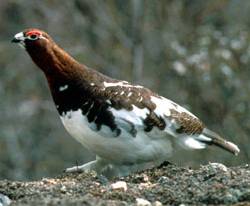Willow Grouse (Lagopus lagopus) - Wiki Willow Grouse
From Wikipedia, the free encyclopedia
[Photo] Willow Ptarmigan (Lagopus lagopus). Lagopus lagopus alascensis in autumn plumage, Lake Clark National Park. Source:US National Park Service, Lake Clark National Park
The Willow Grouse (Europe) or Willow Ptarmigan (North America), Lagopus lagopus, is a medium-sized gamebird in the grouse family. It is a sedentary species, breeding in birch and other forests and tundra across northern Eurasia, and in Alaska and northern Canada. It is the state bird of Alaska. During the last ice age, the species occurred in continental Europe (Tomek & Boche??ski 2005).
The spring male is brown above with a reddish neck and white wings and underparts. The female is similar, but lacks the pure white belly. In winter, both sexes' plumages become completely white except that the tail is black. They can be distinguished from the winter Ptarmigan by habitat (not venturing above the tree line), larger size, thicker bill, and lack of black between the eye and bill in the winter male.
The distinctive British subspecies, the Red Grouse (Lagopus lagopus scoticus) has sometimes been considered a separate species. It is a moorland bird, and is basically reddish brown in all plumages, never going white.
The male's song is a loud "go-back go-back".
These are hardy vegetarian birds, but insects are also taken by the developing young.
The male Willow Grouse is unique in its nesting behaviour. In all other species of grouse, only the female takes responsibility for the young. However, the male Willow Grouse often takes responsibility of the young by staunchly defending his territory and his young. Males have even been documented to have attacked a Grizzly Bear and will attack humans who distract their young.
Scientific name
The Willow Grouse's scientific name, Lagopus lagopus is derived from Ancient Greek lagos (λαγω??), meaning "hare", + pous (που??), "foot", in reference to the bird's feathered legs (see also Snowshoe Hare).
Folklore
In Finnish Lapland, the Willow Grouse was considered "the bird of God" and represented purity, often being associated with females. In some parts of the country, parents would hang the legs and wings of a white grouse over a baby girl's cot to make sure she grew up virtuous. In Finnish folklore the willow grouse, like other birds of the grouse family, were considered spirit messengers and any unusual grouse behaviour was interpreted as a bad omen, most often death or illness.
http://en.wikipedia.org/wiki/Willow_Grouse
| The text in this page is based on the copyrighted Wikipedia article shown in above URL. It is used under the GNU Free Documentation License. You may redistribute it, verbatim or modified, providing that you comply with the terms of the GFDL. |
